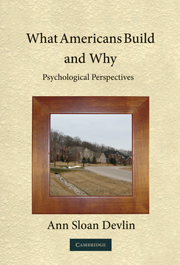Book contents
- Frontmatter
- Contents
- List of Figures
- Preface
- Acknowledgments
- 1 The Landscape of Housing: Suburbia, New Urbanism, and McMansions
- 2 The Landscape of Health Care: High Tech and Humanistic
- 3 The Landscape of Schools: Big Schools, Small Schools
- 4 The Landscape of Work: Visible or Virtual?
- 5 The Landscape of Retail: Big Box and Main Street
- Closing Comments
- Index
3 - The Landscape of Schools: Big Schools, Small Schools
Published online by Cambridge University Press: 05 June 2012
- Frontmatter
- Contents
- List of Figures
- Preface
- Acknowledgments
- 1 The Landscape of Housing: Suburbia, New Urbanism, and McMansions
- 2 The Landscape of Health Care: High Tech and Humanistic
- 3 The Landscape of Schools: Big Schools, Small Schools
- 4 The Landscape of Work: Visible or Virtual?
- 5 The Landscape of Retail: Big Box and Main Street
- Closing Comments
- Index
Summary
PERSONAL REFLECTIONS
I know my parents had good intentions regarding our schooling when they insisted on keeping all five of us (me, my sister, and three brothers) in the laboratory schools of the University of Michigan's Department of Education, rather than allowing us to attend public school. In retrospect, the freedom characteristic of these lab schools was probably a much better fit for some of my siblings than for others. These schools were University Elementary School (UES) and University High School (UHS).
These schools, especially the elementary school, were wonderful environments for learning, and the physical facilities played a role in creating a supportive environment. In addition to a typical gymnasium, the elementary school had what we called The Rhythm Room, constructed with wood planked flooring and an indoor slide for recess on rainy days and Michigan's cold winter months. The center hall of the elementary school was lined with Pewabic tile (see Figure 3.1) from the nationally known pottery founded in 1903 during the Arts and Crafts movement. The centerpiece of the hallway was a small fountain across from the main entrance to the school. The high school had a gymnasium, as well as a room for gymnastics and fencing. There was also a “shop” for woodworking and a separate house with a kitchen for home economics.
- Type
- Chapter
- Information
- What Americans Build and WhyPsychological Perspectives, pp. 116 - 170Publisher: Cambridge University PressPrint publication year: 2010



